 |
Home > Pavilion > Architecture

|
One of the most visually striking pavilions in Future World, Universe of Energy truly represents "ultramodern"
design at its finest. However, the pavilion we see today is far from what was originally conceived by its designers.
According to group member "Dr. Lao", it was originally intended as a "solar energy pavilion," which would have
incorporated a "solar dish" or parabolic collector of sorts. Exxon's involvement in the pavilion changed the
direction somewhat, rendering solar but one of the energy sources to be covered.
|

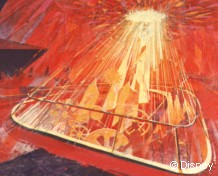
 |
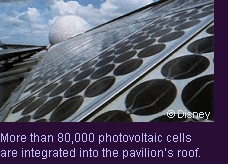 As the design process evolved, Imagineers decided the best way to incorporate solar energy into the
new, more encompassing design, was to use photovoltaic cells--which convert light directly into electricity.
This meant that careful consideration had to be given to the building's shape, as well as its orientation in
the park, so that the cells could receive the optimum amount of exposure to sunlight year 'round. After analyzing
the position of the sun in Orlando throughout the course of a year, it was determined that the cells would be best
situated in a due south orientation and tilted at 30° from horizontal. To further enhance the look of the
pavilion, as well as to showcase the massive solar array, designers gently slanted the entire front half of the
pavilion's roof toward the ground so that guests would actually be able to see the array of cells from the ground,
as opposed to hiding them atop a regular flattop roof.Beginning at a height of 20 feet just above the entry doors
at the entrance to the pavilion, the roof rises to a height of 60 feet at the building's rear. This one move truly
gives the pavilion a sense of graceful elegance, despite its immense size and powerful presence in Future World.
As the design process evolved, Imagineers decided the best way to incorporate solar energy into the
new, more encompassing design, was to use photovoltaic cells--which convert light directly into electricity.
This meant that careful consideration had to be given to the building's shape, as well as its orientation in
the park, so that the cells could receive the optimum amount of exposure to sunlight year 'round. After analyzing
the position of the sun in Orlando throughout the course of a year, it was determined that the cells would be best
situated in a due south orientation and tilted at 30° from horizontal. To further enhance the look of the
pavilion, as well as to showcase the massive solar array, designers gently slanted the entire front half of the
pavilion's roof toward the ground so that guests would actually be able to see the array of cells from the ground,
as opposed to hiding them atop a regular flattop roof.Beginning at a height of 20 feet just above the entry doors
at the entrance to the pavilion, the roof rises to a height of 60 feet at the building's rear. This one move truly
gives the pavilion a sense of graceful elegance, despite its immense size and powerful presence in Future World.

Energetic Architecture
Before guests even enter the magnificent 105,000 square foot structure (roughly the same area covered by
6½ football fields), the idea of energy is already conveyed though numerous elements in the building's
sleek design. The sloping structure seems to rise majestically out of the ground, almost implying the idea
of kinetic energy (or energy in motion), while at the same time appearing to be "driven" into the ground
at its apex.



The more than 180,000 square mirrors that adorn the outside of the structure reinforce the concept of
kinetic energy. These mirrors make the building seem to shimmer and sparkle from sunlight reflecting off
of the rippling waters in nearby reflecting pools. This conveys the idea of "energy in constant motion."
It also reminds guests of the integral role the sun plays in not only powering the attraction, but also
its importance in our lives.
Even the original exterior colors of the pavilion, which seemed to fade from a deep red, to orange
and finally to yellow, suggested the notion of radiating energy.
Beyond the visual cues, the idea of "energetic architecture" takes on a more literal meaning, in the
2-acre rooftop array of 2,156 solar panels. The panels are masterfully integrated into the design of
the structure itself--dispelling the images of the functional but often ugly solar installations so
common in the 70's and early 80's.
Through these clever and resourceful design elements, the guest is introduced to the idea of energy even
before they even set foot inside the attraction.

It's Hip to be Square
The main recurring design motif used throughout the pavilion is based on the simple geometric forms of
the square and the grid. Although some of the architectural elements that helped reinforce this motif
were lost during the 1996 rehab of the pavilion, upon close inspection, one can still see how much of
the pavilion's original design was in fact based on the square.
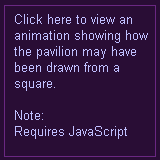 Although it's difficult to discern from the ground, if one were to look at the pavilion from overhead,
they could clearly see that the overall shape of the structure itself is actually almost a perfect square.
The architect more than likely started with a square, rotated it so that the apex of one of the corners
faced inward toward Future World, and began subdividing it until they achieved the form that we see today.
Although it's difficult to discern from the ground, if one were to look at the pavilion from overhead,
they could clearly see that the overall shape of the structure itself is actually almost a perfect square.
The architect more than likely started with a square, rotated it so that the apex of one of the corners
faced inward toward Future World, and began subdividing it until they achieved the form that we see today.
But the square motif doesn't stop here. It can also be seen in the thousands of square mirrors that cover
the building's exterior, as well as in the multi-shaded blue square tiles that cover the bottom of the
reflecting pool.
Immediately upon entering the pavilion, guests encounter a wall covered in tens of thousands of small
square tiles that compose a thermal image of the sun. While the sun takes up the majority of the mural,
the earth is represented in correct proportion--as a tiny white dot on the far right side. Those who
notice this detail gain a great perspective of how immense and powerful our sun really is.
With the original show, one would have entered the pre-show theater and encountered a large motion
picture screen that measured 90 feet long by 14 feet high. The screen itself was comprised of 100
rotating square elements (each measuring approximately 3½ feet square). During the film,
these elements would continually rotate to different positions, constantly segmenting the images
being projected onto the screen, into different grid-like patterns. Although the "Kinetic Mosaic"
pre-show screen was removed during the 1996 rehab, the current pre-show screen is still segmented
into five large square screens, so in a sense, the square motif is still somewhat present here
(although not as apparent as it once was).

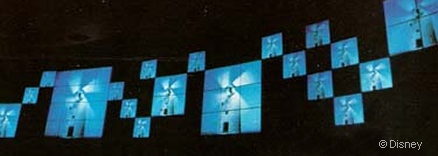

In the original show, the square motif could be seen one final time in Theater I during the show's
climactic finale. During the finale, the curtains lining the theater's side walls were raised to
expose large square mirrors covering the walls. This created somewhat of a grid pattern on both of
the Theater's two main walls. Sadly, these mirrors were removed from the walls of Theater I during
the 1996 rehab and replaced with black, sound-proof insulation.

The Inside Story
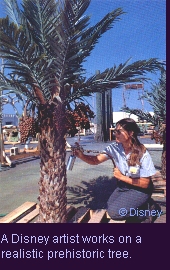 Use of creative architectural design can also be found on the building's interior. The primary example
of this is in the design of the primeval diorama. Among one of the most complex components of the
diorama was in the creation of the more than 250 prehistoric trees that rise to heights of 40 feet
in the air. A lightweight foamed plastic, whose molecular characteristics are similar to the cellulose
structure of a plant's wood pulp, was used to create the vegetation. This special plastic mimics the
tensile and compressive characteristics of actual trees, which are actually capable of swaying in
breezes generated by blowers located in the ceiling of the diorama.
Use of creative architectural design can also be found on the building's interior. The primary example
of this is in the design of the primeval diorama. Among one of the most complex components of the
diorama was in the creation of the more than 250 prehistoric trees that rise to heights of 40 feet
in the air. A lightweight foamed plastic, whose molecular characteristics are similar to the cellulose
structure of a plant's wood pulp, was used to create the vegetation. This special plastic mimics the
tensile and compressive characteristics of actual trees, which are actually capable of swaying in
breezes generated by blowers located in the ceiling of the diorama.
Another impressive feature of the diorama is the scenic backdrop that lines the perimeter of the
marsh scene. The backdrop, which was painted inside of an immense soundstage on the MGM Studios back
lot in California, measures 32 feet in height, and 515 feet in length. It took three Disney artists
a total of 6,000 man-hours to paint.

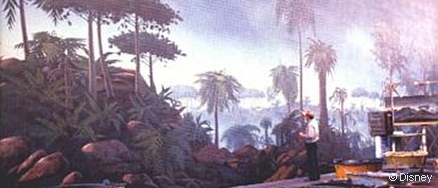


Expanding Space
Unfortunately, the idea behind another creative design was lost during the 1996 rehab. The distinctive
wedge shape of Theater I played an important role during the show's finale. During the finale, curtains
that normally covered the theater's walls were fully raised to expose large mirrored walls. The reflection
of the two mirrored walls against each other along with the theater's 157 foot long curved rear wall
seemingly transformed the wedge-shaped space into a full circle. This gave the illusion that the rear
movie screens wrapped completely around the audience a full 360° as well as made half cylindrical apex
screen at the front of the theater appear to be a "full cylinder," thereby placing the audience inside
what appeared to be a "donut" shaped room nearly 300 feet in diameter (or roughly the length of a football
field).
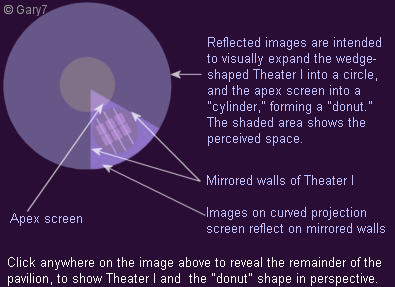

Conclusion
The design of the Universe of Energy still remains one of the most imaginative, as well as visually
stunning pavilions in Future World, and perhaps all of Epcot. Although many changes have been made
to the pavilion over the years, and some of the original design elements have been lost, it still
remains true to its original design concept of being a place for showcasing and inspiring the idea
of energy in all who visit.


Related Pages
Solar
Read more about the pavilion's use of solar energy in our Ride and Show Technology section. You'll also
get a better look at the "Solar Energy Pavilion" image shown above.
Rehab
The 1996 rehab significantly changed the show's finale. The mirrors were removed from Theater I's side walls and
replaced with soundproofing material.


Special Thanks
We'd like to offer a special "thank you" to Dr. Lao for the artist's rendering and information on the
Solar Energy pavilion.
For additional credits and information, visit our Credits page.

|
 |
|
|





